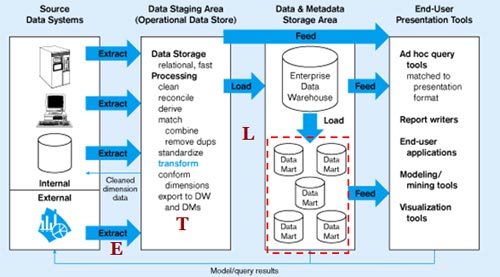Stand Alone Data Mart & Independent Datamart
A data mart is the access layer of the data warehouse environment that is used to get data out to the users. The data mart is a subset of the data warehouse that is usually oriented to a specific business line or team. Data marts are small slices of the data warehouse. Whereas data warehouses have an enterprise-wide depth, the information in data marts pertains to a single department. In some deployments, each department or business unit is considered the owner of its data mart including all the hardware, software and data. This enables each department to use, manipulate and develop their data any way they see fit; without altering information inside other data marts or the data warehouse. In other deployments where conformed dimensions are used, this business unit ownership will not hold true for shared dimensions like customer, product, etc.
The reasons why organizations are building data warehouses and data marts are because the information in the database is not organized in a way that makes it easy for organizations to find what they need. Also, complicated queries might take a long time to answer what people want to know since the database systems are designed to process millions of transactions per day. While transactional databases are designed to be updated, data warehouses or marts are read only. Data warehouses are designed to access large groups of related records.
Data marts improve end-user response time by allowing users to have access to the specific type of data they need to view most often by providing the data in a way that supports the collective view of a group of users.
A data mart is basically a condensed and more focused version of a data warehouse that reflects the regulations and process specifications of each business unit within an organization. Each data mart is dedicated to a specific business function or region. This subset of data may span across many or all of an enterprise’s functional subject areas. It is common for multiple data marts to be used in order to serve the needs of each individual business unit (different data marts can be used to obtain specific information for various enterprise departments, such as accounting, marketing, sales, etc.).
The related term spread mart is a derogatory label describing the situation that occurs when one or more business analysts develop a system of linked spreadsheets to perform a business analysis, then grow it to a size and degree of complexity that makes it nearly impossible to maintain.
Reasons for creating a data mart
- Easy access to frequently needed data
- Creates collective view by a group of users
- Improves end-user response time
- Ease of creation
- Lower cost than implementing a full data warehouse
- Potential users are more clearly defined than in a full data warehouse
- Contains only business essential data and is less cluttered.
Stand-alone data mart
A Stand-alone data mart focuses exclusively on one subject area and it is not designed in an enterprise context. For example, manufacturing has their data mart, human resources has their, finance has their and so on. stand-alone data mart gets data from multiple transaction systems in one subject area or department to support specific business needs. stand-alone data mart may use dimensional design or entity-relationship model. Analytic or business intelligence tools query data directly from data mart and present information to user. The picture below is a typical Stand-alone data mart.

Stand-alone data mart takes very short time to build and bring the visible result to specific departments with less cost. However if you look at the whole system landscape where multiple data marts exist, you will see that different ETL tools need to built for different transaction systems in different technologies and the data is duplicate in several data marts. From business perspective, each data mart is built to address a set of specific business needs, what if the needs expand? And what if you want to analyze data across function or department? The inconsistent data, such as definition of product, will make the information comparison between departments impossible.
Dependent data mart
According to Bill Inmon, a dependent data mart is a place where its data comes from a data warehouse. Data in a data warehouse is aggregated, restructured, and summarized when it passes into the dependent data mart. The architecture of a dependent data mart is as follows:


